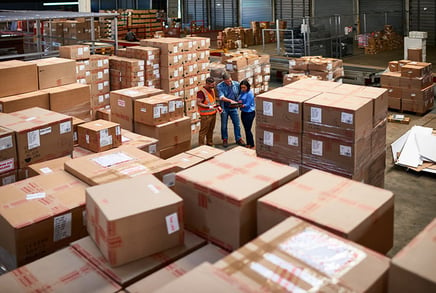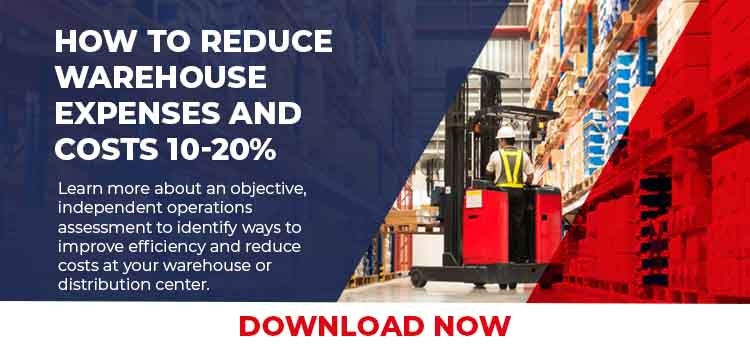 Warehouses are expensive for companies to operate considering the total fulfillment costs of labor, occupancy, and storage and material handling assets. Often, warehouse space is 15 to 20% of the cost per order.
Warehouses are expensive for companies to operate considering the total fulfillment costs of labor, occupancy, and storage and material handling assets. Often, warehouse space is 15 to 20% of the cost per order.
Increasing capacity of the warehouse should not be confined to changes in space use and increasing stock locations only. The assessment and solutions need to take into account the warehouse layout, product flow, labor efficiency, storage and material handling options, safety, throughput, and warehousing system functions, to name a few elements. It’s the integration of these elements that makes for efficiency.
Is a new warehouse the right choice?
Moving to new warehouse space is expensive after accounting for leases, build out, racking and material handling equipment, and moving merchandise. Additionally, even existing facilities take a lot of elapsed time – 6 to 12 months from signing the lease. Build to suite options take 24 months, at the shortest. So, most companies work to gain more from the space they have.
As we evaluate multichannel warehouse operations, we are commonly asked, “When is a warehouse at capacity?” We find when a warehouse is between 80 to 85% space utilization, warehouse efficiencies typically drop from a movement and storage perspective. Four common consequences of reaching capacity are:
- Pallet movement becomes very restricted. Each move and replenishment may take multiple actions to complete.
- Temporary floor pallet positions may restrict aisle movement, too.
- Multiple touches or moves of a product increase costs and slow down processing.
- Many businesses need to improve utilization or find new warehouse space earlier than expected.
If you decide that a new warehouse is the right direction for your company, we recommend starting your search by determining how much space is needed in a new center.
Improve current warehouse space use
In doing a space use study, here are 20 considerations:
1. Perform an evaluation
Here are some of the objectives F. Curtis Barry & Company sets with clients for warehouse assessments to improve warehouse space use:
- How well is the facility being utilized in terms of layout, capacity, storage, and material handling equipment?
- What are the space needs by department. For example, how much space is needed for receiving and staging for put away; pick cart waiting packing; packing stations and materials; and returns processing?
- What are the layout merits in terms of inbound product flow and outbound order processing?
- How do space needs change during peak periods?
- What are the returns processing space requirements for high return merchandise categories?
- What types of storage media are used - floor stack, pallet rack, shelving, or carousel?
- What material handling, automated sortation, and conveyance systems are used?
- What information system support from OMS, ERP or WMS (e.g. inventory management, slotting, directed put away) is used?
- What is the current capacity and lifespan of the distribution center?
- What is the best long-term distribution strategy? Is it a single center, multi-DC, or additional local facilities?
- What are the storage options within the current facilities?
These observations should give you the details and data needed to determine what opportunities there are for improvement.
2. Identify overstock with senior management and the merchants
One of the first - and toughest - things to address is whether the merchants can reduce space used by focusing on the age of the inventory and liquidating overstock.
Should this be an early objective in your DC space study? Do you have inventory reporting that shows, by SKU, the weeks of supply and the inventory turnover at peak and average week? These are key reports to discuss with management and the merchants. Many companies have 10 to 20% of their space tied up with slow moving or obsolete stock.
3. Determine the best utilization of the building
Make sure you study your building to determine how it can be best utilized. Consider clear stacking height, column spacing, building impediments, and overall process flow. Try to match vertical space needs with the building characteristics.
4. Use vertical space and cube
Look up. Are you using all of the vertical space available to you? Investigate storage media that allow you to take advantage of the warehouse clear span height. How much cubic feet are not used? Be sure to know how your design might impact your sprinkler system and fire code compliance.
5. Appropriately use department space
Try to locate functions that do not require high ceilings in areas where lower stacking heights are dictated by the clear height of the warehouse. We often see unused overhead space where large departments like packing and shipping are performed.
6. Consolidate locations
Try combining multiple locations of the same item to better utilize the locations you have. This can be done during the put away process and as a standalone function.
7. Use the right size slots
Maximize the utilization of the picking slot cube by matching the size and sales of the item to the right size pick slot. Using various sizes of picking slots can facilitate this process. The same logic applies to locations where you store reserve or overstocks. In forward picking, keep 4-7 days sales by SKU. This reduces replenishment runs.
8. Use off-site for overstock or backstock
If you find yourself storing a large quantity of excess inventory for a few items, consider some type of off-site storage for the excess. This will free up space for supporting the fulfillment operation.
9. Maximize aisle widths
What are the widths of your warehouse aisles? Try to design the minimum width required to match the material handling equipment used without compromising operating efficiencies. Narrow aisle (aisle width 9 to 10 feet) and very narrow aisle (aisle width 6 feet) racking configurations will increase product storage considerably. But, these require costly specialized high reach and forklift material handling.
10. Consider depth of storage
Review not only the effective use of the height of facilities, but also the depth of storage racking systems. For example, double deep rack may enable you to store large SKU quantities. Consider these types of storage and appropriate material handling equipment.
11. Minimize supply storage
If you store supplies or packing materials, try to manage the inventory to avoid overstocks. Investigate the possibility of your corrugated supplier keeping some inventory at their site and your company taking delivery on a just-in-time basis.
12. Consider door use
If you have separate shipping and receiving docks, consider combining them to save space - assuming it will not decrease efficiency.
13. Install a mezzanine
If your building can accommodate and is permitted by the landlord, consider installing a mezzanine to house functions that do not require high bay storage. Mezzanines can be expensive and are fairly permanent but will maximize space use.
READ: 12 Considerations for Adding Space to Your DC Using Mezzanines
14. Use space over dock doors
Is this space that can have racking installed and be used for product storage? If so, will this interfere with dock operations?
15. Use warehousing systems to help manage and use space efficiently
Does your warehousing system – WMS, OMS or ERP – have more advanced functionality to assist with DC inventory management? Examples include functionality to improve slotting, directed put away, and inventory consolidation function. Are there add-on systems to bring more function?
READ: How to Improve Your e-Commerce Warehouse Slotting
16. Consider multiple design layouts and rack configurations
As you work through different options, it is very helpful to use CAD software to quickly generate iterations and see how different floor plans and racking configurations change storage.
17. Consider using third-party fulfillment
If a new facility is warranted, consider using third-party logistics (3PL). Experienced 3PL firms can give you same day to next day shipping coverage closer to the customer at competitive prices.
18. Consider drop shipping as an option
If you store and ship large items, consider utilizing some form of drop shipping to reduce your in-house inventory, open up space and reduce inventory cost.
19. Assign responsibility for space utilization
Make sure you assigned someone, or a position, to be responsible for the ongoing space planning and utilization analysis process.
20. Evaluate potential solutions
Where you have a choice between a complex and simple solution, choose the simple solution. An example of a simple solution is adding pallet rack tiers upwards. A complex example is moving rack to narrow aisles. Consider the disruption to business and the additional cost for reach and forklift equipment. Is there a return on investment for your solutions?
Summary
Moving to a new facility is expensive and requires 6 to 12 months from contract signing. Get the most storage and productivity from the warehouse you have, then consider a new facility.







SHARE